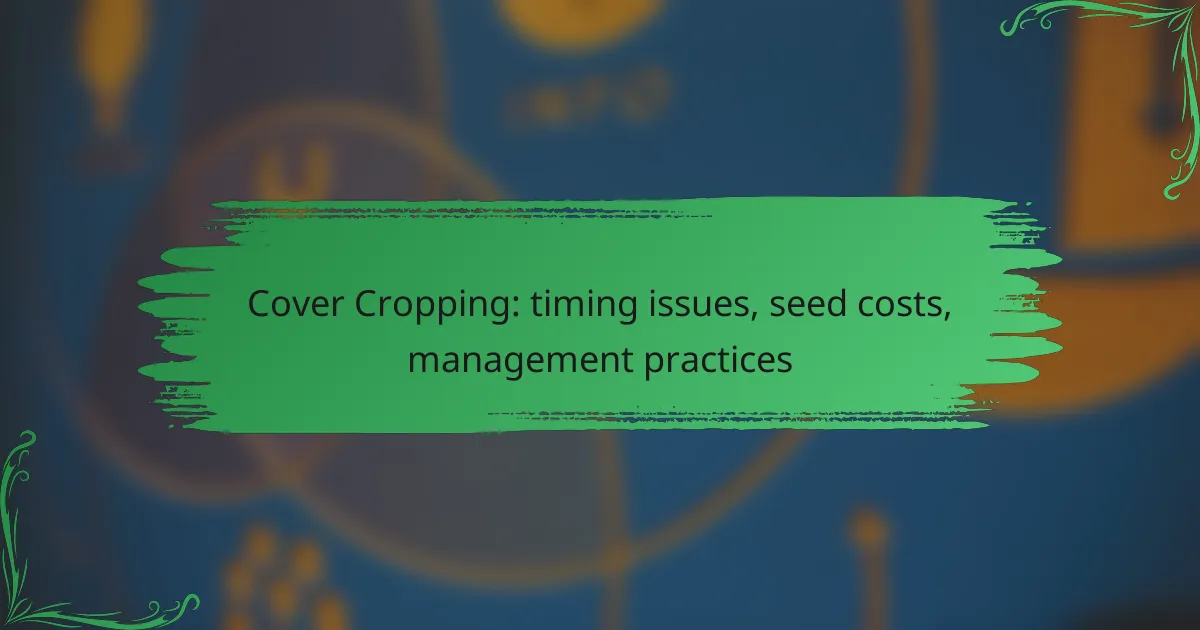Regenerative agriculture represents a transformative approach to farming that focuses on enhancing soil health and biodiversity while fostering ecosystem resilience. During the transition period, farmers may experience yield variability due to environmental factors and soil conditions, making adaptability essential for economic sustainability. To support this shift, a wealth of educational resources is available, offering practical knowledge and skills for successful implementation of regenerative practices.

What are the best practices for transitioning to regenerative agriculture?
Transitioning to regenerative agriculture involves adopting practices that enhance soil health, increase biodiversity, and improve ecosystem resilience. Key practices include crop rotation, soil management, cover cropping, livestock integration, and community-supported agriculture.
Crop rotation techniques
Crop rotation involves alternating different crops in the same field over time to improve soil fertility and disrupt pest cycles. This practice can enhance nutrient availability and reduce reliance on chemical fertilizers. For example, rotating legumes with cereals can fix nitrogen in the soil, benefiting subsequent crops.
When planning a rotation, consider the growth habits and nutrient needs of each crop. A common approach is to use a three- to four-year cycle that includes a mix of deep-rooted and shallow-rooted plants to maximize soil structure and health.
Soil health management
Soil health management focuses on maintaining and improving soil quality through practices that enhance organic matter and microbial activity. Techniques such as reduced tillage, compost application, and organic amendments can significantly boost soil health. Healthy soil leads to better water retention and nutrient cycling.
Regular soil testing is essential to monitor pH, nutrient levels, and microbial activity. Aim for a balanced soil profile to support diverse crops and minimize the need for synthetic inputs.
Cover cropping strategies
Cover cropping involves planting specific crops during off-seasons to protect and enrich the soil. These crops can prevent erosion, suppress weeds, and improve soil structure. Common cover crops include clover, vetch, and rye, which can be chosen based on local climate and soil conditions.
Incorporating cover crops into your rotation can enhance soil organic matter by adding biomass. Aim to plant cover crops at least a month before the first frost to maximize growth and benefits.
Livestock integration methods
Integrating livestock into regenerative systems can enhance nutrient cycling and improve pasture health. Practices such as rotational grazing allow animals to graze in a controlled manner, promoting plant regrowth and soil aeration. This method can lead to healthier pastures and reduced feed costs.
Consider the balance between livestock numbers and pasture capacity to prevent overgrazing. A good rule of thumb is to rotate livestock every few days to allow pastures time to recover.
Community-supported agriculture models
Community-supported agriculture (CSA) connects farmers directly with consumers, providing a stable income for producers while offering fresh produce to local communities. Members typically pay upfront for a share of the harvest, which can help farmers manage cash flow during the transition period.
Establishing a CSA requires clear communication with members about what to expect throughout the growing season. Consider offering a variety of products to meet diverse consumer preferences and enhance community engagement.

How does yield variability affect regenerative agriculture?
Yield variability significantly impacts regenerative agriculture by influencing both production consistency and economic viability. Fluctuations in crop yields can arise from various factors, including environmental conditions, soil health, and market dynamics, making it crucial for farmers to adapt their practices accordingly.
Impact of climate on yields
Climate plays a pivotal role in determining agricultural yields, particularly in regenerative systems that rely on natural processes. Changes in temperature, precipitation patterns, and extreme weather events can lead to unpredictable harvests, affecting food supply and farmer income.
For instance, a dry season may reduce yields by a significant margin, while excessive rainfall can lead to soil erosion and nutrient leaching. Farmers should monitor climate forecasts and consider diversifying crops to mitigate these risks.
Soil fertility and yield correlation
Soil fertility directly correlates with crop yields in regenerative agriculture, where maintaining healthy soil is essential. Practices such as cover cropping, crop rotation, and organic amendments can enhance soil structure and nutrient availability, leading to improved yields.
Farmers should regularly test soil health and adjust their management practices based on the results. Investing in soil health can lead to more stable yields over time, reducing the variability caused by nutrient deficiencies.
Market demand fluctuations
Market demand fluctuations can greatly influence the economic outcomes of regenerative agriculture. Changes in consumer preferences, seasonal trends, and global market conditions can lead to varying prices for crops, impacting farmers’ profitability.
To navigate these fluctuations, farmers can explore direct-to-consumer sales channels, such as farmers’ markets or community-supported agriculture (CSA) programs. This approach can provide more stable income and reduce reliance on volatile market prices.

What educational resources are available for regenerative agriculture?
Numerous educational resources exist for those interested in regenerative agriculture, ranging from online courses to hands-on workshops. These resources aim to equip farmers and enthusiasts with the knowledge needed to implement sustainable practices effectively.
Online courses from universities
Many universities offer online courses focused on regenerative agriculture, often as part of broader agricultural or environmental science programs. These courses typically cover topics such as soil health, crop rotation, and biodiversity, providing a solid foundation for understanding regenerative practices.
Examples include programs from institutions like Cornell University and the University of California, which may offer free or low-cost options. Participants can expect to engage with interactive materials, video lectures, and assessments to reinforce their learning.
Workshops by local agricultural organizations
Local agricultural organizations frequently conduct workshops that provide practical, hands-on training in regenerative techniques. These workshops are beneficial for farmers looking to transition to regenerative practices, as they often include demonstrations and real-world applications.
Attending these workshops can also foster community connections, allowing participants to share experiences and strategies. Check with local extension services or agricultural cooperatives for upcoming events in your area.
Books on regenerative practices
A variety of books are available that delve into the principles and practices of regenerative agriculture. These texts often include case studies, step-by-step guides, and insights from experienced practitioners, making them valuable resources for both beginners and seasoned farmers.
Some recommended titles include “The Regenerative Agriculture Handbook” and “Dirt to Soil.” These books can serve as comprehensive references, offering practical advice on implementing regenerative methods in diverse agricultural settings.

What are the prerequisites for adopting regenerative agriculture?
Adopting regenerative agriculture requires a solid understanding of local conditions, including soil types and water availability. These prerequisites help farmers make informed decisions that enhance soil health and crop resilience.
Understanding local soil types
Knowledge of local soil types is crucial for implementing regenerative agriculture effectively. Different soils have varying nutrient profiles, drainage capabilities, and organic matter content, which influence crop growth and health.
Farmers should conduct soil tests to determine pH, texture, and nutrient levels. This information can guide practices such as cover cropping, crop rotation, and amendments to enhance soil fertility and structure.
For example, sandy soils may require more frequent organic matter additions, while clay soils might benefit from practices that improve aeration and drainage.
Assessing water availability
Assessing water availability is essential for successful regenerative agriculture. Understanding both surface and groundwater sources helps farmers plan irrigation strategies that align with sustainable practices.
Farmers should evaluate seasonal rainfall patterns, water table levels, and the efficiency of existing irrigation systems. This assessment can inform decisions on drought-resistant crops and water conservation techniques.
For instance, implementing rainwater harvesting or drip irrigation can significantly reduce water usage while maintaining crop yields, especially in regions with limited water resources.

How can farmers measure the success of regenerative practices?
Farmers can measure the success of regenerative practices through various indicators, including soil health, yield stability, and ecological balance. These metrics provide insights into the effectiveness of regenerative methods over time.
Soil health indicators
Soil health indicators are critical for assessing the success of regenerative agriculture. Key metrics include organic matter content, microbial activity, and nutrient availability. Farmers can use soil tests to monitor these factors, aiming for a minimum organic matter level of 3-5% for optimal health.
Regular assessments can reveal changes in soil structure and fertility, which are essential for sustainable crop production. Visual indicators, such as earthworm populations and root depth, also serve as practical signs of improved soil health.
Yield comparisons over time
Yield comparisons over time help farmers evaluate the effectiveness of regenerative practices. Initially, yields may fluctuate as the soil ecosystem adjusts, but over several growing seasons, many farmers observe a trend toward increased stability and resilience. Comparing yields year-over-year can highlight improvements in crop performance.
Farmers should track yields against conventional practices to understand the benefits of regeneration. It’s advisable to maintain detailed records of crop outputs, noting any variations due to weather or management changes, to gain a clearer picture of long-term trends.



